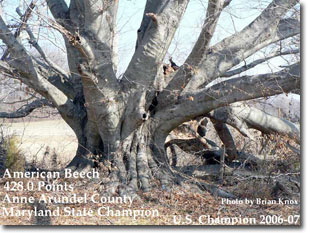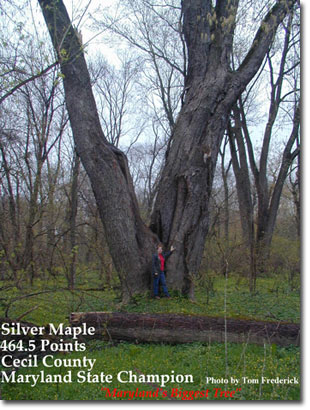
Trees are the oldest and largest of living things. There are several in this state reported to be more than four centuries old. In 1976, the Department of Natural Resources Forest Service published a booklet entitled “Maryland’s Bicentennial Trees and A Listing of Species of Trees Believed to be Living in Maryland in 1776”. Volunteers from the Maryland Big Tree Program and local Forestry Boards are working on locating, measuring and updating this list so it will be ready for our nation’s 250th anniversary.
Currently there are 137 species of trees with registered examples in Maryland (see Maryland State Champion Tree List above). ‘Trees’ are defined as having a circumference of 9.5” (diameter of 3”), and a height of at least 13’. The list includes trees that are native or naturalized, meaning they can grow and reproduce on their own. Some of the “native” trees are not native to Maryland, but have been planted and have found to grow well in our climate.
We are aware of other tree species that probably exist in Maryland but for which we have no registered example. A complete list of “eligible” tree species can be found at the American Forest web site, www.americanforest.org.
 The Maryland Big Tree Program does not keep a list of “exotic” tree species in Maryland. These are defined as trees that are not native, do not naturalize, but can grow in Maryland and are planted in back yards and other landscapes because they have unique features that are attractive. Some of these “exotic” species can grow quite large, such as ginkgo, European beech, horsechestnut, English elm, and others. If these trees are nominated by Maryland citizens, we will measure and register them, but we do not list them as species eligible for championship status. Many local forestry boards maintain their own lists of species found in their counties, and they usually include county champion “exotic” species.
The Maryland Big Tree Program does not keep a list of “exotic” tree species in Maryland. These are defined as trees that are not native, do not naturalize, but can grow in Maryland and are planted in back yards and other landscapes because they have unique features that are attractive. Some of these “exotic” species can grow quite large, such as ginkgo, European beech, horsechestnut, English elm, and others. If these trees are nominated by Maryland citizens, we will measure and register them, but we do not list them as species eligible for championship status. Many local forestry boards maintain their own lists of species found in their counties, and they usually include county champion “exotic” species.
The Maryland Big Tree Program State Champion Tree List does include species that are considered invasive. We do not condone the planting of invasive species; in fact we encourage the removal of these species. However, we use the American Forest rules for inclusion of species, and it is currently their policy to include invasive species on their list. This policy is constantly being reviewed and we will change our policy if/when American Forest makes a change.
The importance of trees, not only in our landscape, but in our very way of life, gains recognition by more people every day. Maryland residents have shown a universal interest in “Big Trees,” since the first State Forester, Fred W. Besley, compiled the “Noted Tree List” for Maryland in 1925. As the “Noted Tree List” grew, it became apparent to Mr. Besley that there should be a permanent, published record. He started an intensive search for big trees of all species growing in Maryland, and a statewide contest was held, greatly increasing the number of nominations for Big Tree Champions. The search continues to the present time and the list changes constantly.
Trees are subject to the ravages of man, machines, insects, disease, nature and time. In order to keep the list up-to-date, “The Big Tree Champions of Maryland” was published in 1937, 1956, 1973, 1990 and 2002. This list is now compiled electronically and updated as a new champion or new species is identified. The updated list will be posted at this location from time to time.
Due to the size of the database, limits have been established as to the size of trees that can be registered.
There are 3 criteria:
- Trees must be at least 300 points, or
- Trees must be at least 70% of the current State Champion, or
- Trees must be a county champion.
 To evaluate the relative size of a tree, the girth (circumference) in inches and the height and crown spread in feet are added together to arrive at a number of points for each tree. This number is then used for comparison of tree sizes in each species. This system of measuring gives the trunk much better weight by giving the girth in inches. The formula is: Total Points = Circumference (inches) + Height (feet) + 25% of the Average Crown Spread (feet).
To evaluate the relative size of a tree, the girth (circumference) in inches and the height and crown spread in feet are added together to arrive at a number of points for each tree. This number is then used for comparison of tree sizes in each species. This system of measuring gives the trunk much better weight by giving the girth in inches. The formula is: Total Points = Circumference (inches) + Height (feet) + 25% of the Average Crown Spread (feet).
The rules for measuring trees have evolved over the years. Volunteers from the Maryland Big Tree Program and local forestry board members are trained to follow these rules; therefore we recommend allowing our volunteers to perform the tree measurements. We also require written permission from the tree’s owner in order to measure and register a tree. We encourage citizens to nominate trees in their community. We must be given the owner’s name and contact information before we can drive to a location to measure as we will not investigate the ownership of a property. Trees on public property usually can be measured and registered without written permission, although it is helpful to first check with the public agency in case the property is slated for a project that would affect that tree.
The registration of a big tree confers no protection or restriction upon the property and its owner. There are no funds available to prune, mulch, cable, and otherwise promote the healthy growth and longevity of Maryland Big Trees. On the other hand, the owner of a registered Big Tree retains all property rights of that tree, including the right to remove it at any time for any reason. Once a tree is measured and registered, it is assigned a number which it will carry forever (deceased trees retain their registered number and are listed in an electronic “deceased” file). The owner is mailed a certificate of registration, a letter of congratulations, a list of all the registered trees in Maryland of that species, a county-specific brochure explaining the program, and a bumper sticker proclaiming “Proud Owner of a Maryland Big Tree.”
Almost everyone likes trees for one reason or another. No matter what the reason – aesthetics, financial or sentimental – a tree is a valuable asset. In this last decade of the 20th century, trees have once again attained a position of prominence, not so much for the products derived from them, but from the non-consumptive benefits they provide. Trees use carbon dioxide, the gas associated with global warming and the “Greenhouse Effect,” and give off oxygen through the process of photosynthesis. They act as buffers, filtering out harmful sediment and nutrients before they enter water bodies such as the Chesapeake Bay. A house without trees is unprotected from summer heat, appears unbalanced and suggests a lack of interest on the part of those who live in it. A state without trees would be a barren and desolate place in which to live. A world without trees would, quite literally, be an impossible place in which to live.
Contact John Bennett, 610-467-1247 or at mdbigtreeprogram@aol.com:
For the most up-to-date Big Tree Champions of Maryland
For a copy of your county’s list of Bicentennial Trees
For a list of trees in your county
For more information regarding Maryland’s Big Trees